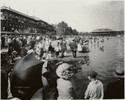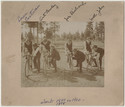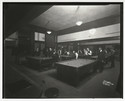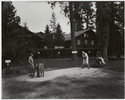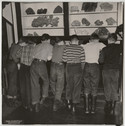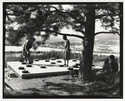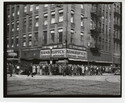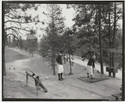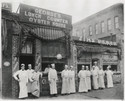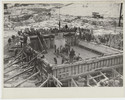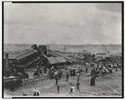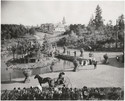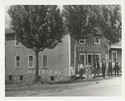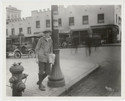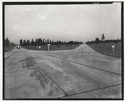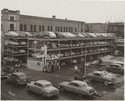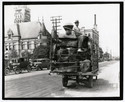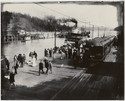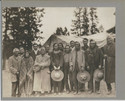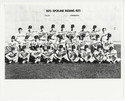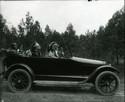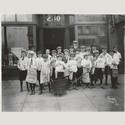African American Community
The Bass Club owned a cabin at Chatcolet Lake in northern Idaho, where members of Spokane’s African American community gathered to enjoy fishing. Photographer Wally Hagin extensively documented the African American community participating in many...
[more]
African American Community
African American Women's baseball team "Carver". Standing left to right: Miss Houston; Mrs. Rosa Malone director of U. S. O.; Olga Armstrong. Seated left to right: Jessie Wellington Sarto; Freddie Mae Huff Petri; Pauline Lake; Mary Hill McFarlin;...
[more]
Amusement Rides at Natatorium Park
Natatorium Park offered fun times and many forms of entertainment. Spokane’s “Coney Island” included amusement rides, traveling shows, sporting events, and public dances. Founded in 1889 as Twickenham Park, Nat Park became a destination point for...
[more]
Beachfront at Liberty Lake
Liberty Lake beaches have been a local favorite for recreation and leisure since the late 1890s. A boardwalk and a band pavilion bordered the lakeside, and a resort hotel and dance hall were built on pilings over the water. An electric train made...
[more]
Bicycle Racers
These four young men were practicing in Spokane’s first park, Coeur d’Alene Park, for a race scheduled at Corbin Park. The fairgrounds at Corbin Park often hosted athletic competitions, racing events, and county fairs. Bicycling found a loyal...
[more]
Billiard Room at the YMCA
The YMCA of Spokane was established in 1884 and originally located on the corner of First and Lincoln. Initially, the YMCA served boys and men, and as well as the Spokane’s labor community. The downtown YMCA hosted many forms of indoor and outdoor...
[more]
Bob's Chili Parlor
Bob’s Chili & Tamales Parlor was popular in the 1920s, establishing Spokane’s reputation for good food and fine restaurants.
Bozanta Tavern
The Bozanta Tavern (designed by architect Kirtland Kelsey Cutter) was built in the early 1900’s on Hayden Lake. The name was changed to the Hayden Lake Country Club in the early 1920s. Hayden Lake and Bozanta Tavern were popular destination points on...
[more]
Campbell House
Architect Kirtland Cutter designed Campbell House in the Tudor Revival architectural style. Mansions at the turn of the century often included a carriage house and a private coachman. The Campbell family’s coachman, Joseph Gladding, drove the family...
[more]
Campbell House Museum
Campbell House, a well-known Spokane landmark and museum, was built in 1898. Spokane architect Kirtland K. Cutter designed the house for the Amasa B. Campbell family, who donated the home to the Eastern Washington State Historical Society in 1925....
[more]
Car Camping
Inland Northwest outdoor enthusiasts soon utilized the automobile, and outdoor motoring fueled the growth of both the National Park and Good Roads movements. By World War I, Spokane sported a large number of cars, including this General Motors...
[more]
Checkers Game
The Royal Riblet mansion, located on Myrtle Peak overlooking the Spokane River, was promoted as the most electrified home in the United States when it was constructed in 1924. Access to the Riblet Mansion was by electric tram across the Spokane...
[more]
Children at the Hutton Settlement
Levi Hutton, who was raised an orphan, used profits from his Idaho silver mining ventures to build the Hutton Settlement. Dedicated to his wife, May Arkwright Hutton, also an orphan, the Hutton Settlement was constructed in the Spokane Valley in...
[more]
Children Berry Picking
Fruits and vegetables thrived in the fertile soil of the Spokane Valley. Strawberry picking remains a popular family activity during berry season. Many local farms, particularly in the community of Green Bluff northeast of Spokane, still open their...
[more]
Christmas at the Louis Davenports
Louis Davenport’s Eighth Avenue home, located approximately where Sacred Heart Hospital now stands, was a prominent Spokane landmark. The home illustrated Spokane’s taste for old European-style architecture and natural landscape. Louis’s son Lewis...
[more]
Dance Pavilion at Natatorium Park
Dances held by civic groups and clubs provided popular entertainment in Spokane. This large crowd filled the Natatorium Park dance pavilion to dance to Phil Harris’ Big Band. Phil Harris was the musical director for Jack Benny’s radio programs....
[more]
Dedication of Union Pacific Viaduct
After the construction of Northern Pacific rail lines through Spokane Falls in 1881, the community became a major transportation hub. Soon thereafter, trains traveled on elevated tracks through the heart of the city. On September 15, 1914, officials...
[more]
Depression Era Bankruptcy Sale
The market value of precious metals and agricultural products significantly impacted Spokane’s economy, and the Great Depression left many unemployed. Many Spokane businesses failed or were forced to sell goods at very low prices. Sales like the one...
[more]
Downriver Golf Course
Spokane’s climate and scenic landscape provided many locations for outdoor sports like golf. The Downriver Golf Course opened in 1926 at its current location next to the Spokane River and Riverside State Park. Tournaments for men and women were...
[more]
Expo ‘74 World's Fair
The 1974 Expo World’s Fair revived interest in preserving and beautifying the landscape surrounding the falls of the Spokane River and provided for the construction of the Spokane Opera House and surrounding riverfront walkways. Spokane, the smallest...
[more]
Farmers' Market
Farmers’ markets were common in Spokane. New roads brought fresh fruits and vegetables each season. The tradition continues today.
Finch House
The Finch residence, located in Browne’s Addition, was constructed in 1898. Kirtland Cutter designed the home in the Colonial Revival architectural style. John Finch was Amasa B. Campbell’s business partner in the lucrative Coeur d’Alene mining...
[more]
Fox Theatre
Spokane’s Fox Theatre is one of the last Art Deco styled theatres surviving in the United States today. Built in 1931 at a cost of one million dollars, the Fox Theatre was designed for traveling vaudeville shows as well as movies. It was the first...
[more]
George's Lunch Counter
Restaurants flourished next to each other in Spokane, providing a wide variety of choice for food fare. George’s Lunch Counter and Oyster House and Jim’s Place fed factory workers and business people.
Gold Star Mothers
Grace Darling Seibold formed the Gold Star Mothers organization in 1928. Chapters were started across the nation in most major cities including Spokane. The organization’s purpose was to promote patriotism and the American ideals that young soldiers...
[more]
Grand Coulee Dam
Grand Coulee Dam was the largest construction project initiated during the depression, and for a time was the largest dam in the world. The project benefited the Inland Northwest by providing jobs for concrete and jackhammer workers, revenue for the...
[more]
Grand Coulee Dam
Grand Coulee Dam was the largest construction project initiated during the depression, and for a time was the largest dam in the world. The project benefited the Inland Northwest by providing jobs for concrete and jackhammer workers, revenue for the...
[more]
Great Northern Railroad Wreck
Occasional train wrecks were commonplace for cities that depended on rail transportation. In 1903, a Great Northern freight train derailed in Spokane. Through the 1920s, most train cars were made of wood, and local lumber mill workers were usually...
[more]
Harvesting Crew
Steam power greatly improved the Inland Northwest’s annual grain harvest. Horse-drawn wagons transported loads of wheat shocks to a threshing center. There, steam engines used long leather belts to operate threshing machines. Men fed wheat manually...
[more]
Japanese American Businesses
Spokane supported a substantial Japanese American community and many of these residents owned small businesses. Most were located together near Front Avenue (now Spokane Falls Boulevard). Japanese residents were not allowed to own property, but many...
[more]
Japanese American Businesses
Spokane supported a substantial Japanese American community and many of these residents owned small businesses. Most were located together near Front Avenue (now Spokane Falls Boulevard). Japanese residents were not allowed to own property, but many...
[more]
Local Saloon
Taverns and saloons attracted many locals after a long day of work. Earnings from mining and logging camps supported much of their business. These establishments became centers for social and community building, as well as relaxation and...
[more]
Manito Park Zoo
Manito Park formed the core of a 1904 residential development on Spokane’s South Hill. Soon after, the city’s new Board of Park Commissioners hired the Olmsted Brothers to create a comprehensive plan for Spokane parks, playgrounds, and parkways. At...
[more]
Marie Antoinette Ballroom
Davenport Hotel ballrooms were popular locations for weddings, dances, and celebrations. The Davenport Hotel opened in 1914 at a cost of three million dollars. The Marie Antoinette Room was a great location for dance parties and a young Helen...
[more]
Medical Lake Sanitarium
The legend of Medical Lake’s healing waters began in 1877. The Medical Lake Sanatorium was built in 1888, resting on the shore of the lake. The original building was eventually torn down and the Eastern Washington State Hospital is located there now.
Miss Spokane Dresses
Clothing and garment manufacturing provided labor jobs in Spokane, primarily for women. Edwards Clothing Manufacturing, located on North Division Street, made clothing for a variety of labels. The women in this photograph were sewing dresses for Miss...
[more]
National Indian Congress
The National Indian Congress sponsored meetings in Spokane in 1925 and 1926. Tribes from the surrounding region and other parts of the country discussed treaty issues, conducted ceremonies, and created unity within the Indian communities. Many events...
[more]
Needlework Class
The Crescent clothing and retail store was a landmark business in the Spokane community. Founded in 1889, the Crescent continued as a prominent retail store until it closed in 1991 when purchased by Frederick & Nelson. The Crescent hosted many events...
[more]
Newsboy
Newsboys were a common sight on Spokane street corners and in front of buildings during the 1920s. To help sell papers, newsboys shouted out headlines to get the attention of people walking or driving nearby. Spokane had several newspapers in the...
[more]
Newsboys
Many young people found work with local newspaper and magazine distributors to earn extra spending money. These youngsters were employees of A.J. Sharples, agent for Curtis Publishing Co., who sold popular periodicals like Ladies Home Journal and The...
[more]
North Division Street
Expansion of the “Y” in 1932, where Division Street and U.S. 195 and 395 split, helped connect the surrounding agricultural areas and opened new property for commercial and residential development. The AAA automobile club (notice the AAA sticker on...
[more]
Northwest Airlines
A Northwest Airlines passenger plane awaits takeoff at Felt’s Field, Spokane’s first airport. The airstrip provided municipal airport services during the 1930s and 1940s and provided a base for the Washington Air National Guard. Felts Field operates...
[more]
Pigeon Hole Parking
Cars, and a need for parking, impacted the look of downtown Spokane. Limited space led to creative solutions like the Pigeon Hole Parking Garage. Using lots that were too narrow for regular structures, Pigeon Hole Parking garages used a hydraulic...
[more]
Prohibition Enforcement
Some Spokane residents actively promoted prohibition laws aimed at controlling the growth and profits of saloons and breweries. In 1915, the State of Washington passed a bill banning the consumption and sale of liquor beginning January 1, 1916....
[more]
Riverside and Monroe
The intersection of Riverside and Monroe streets, so near the Monroe Street crossing of the Spokane River, was an important location in downtown Spokane. Next to the landmark Spokesman-Review building was the Crescent Department Store, the only...
[more]
Salvation Army Donut Line
During the Great Depression, many people migrated to Spokane in search of work and lodging. Community outreach by The Salvation Army provided food and shelter. The Salvation Army sold ‘Famous Doughnuts’ as a way of raising funds, and was known for...
[more]
Salvation Army Promotional Photo
The Salvation Army used this photograph for promotional purposes, advertising food, shelter, and aid during the difficult days of the Great Depression.
Soapbox Racer
Car culture boomed in Spokane during the 1920s. Children participated by building soapbox racers and racing them in competitions. This soapbox racer was named for Harry Clayton Stutz, founder of the Stutz Motor Car Company and famous for creating...
[more]
Spokane & Inland Empire Railroad Dock
Spokane resident’s love of nearby recreation spurred development of electric rail lines from Spokane through Liberty Lake to Coeur d’Alene, Idaho. From Coeur d’Alene, the steamer “Idaho,” and many others, crossed the lake to access more remote areas....
[more]
Spokane and Coeur d'Alene Indians
The Plateau Indians are a large, interconnected community of tribes located between the Cascade and Rocky Mountain ranges. They share similar traditions and language base, and gathered for traditional feasts and celebrations. Members of the Coeur...
[more]
Spokane County Courthouse
Regional architect W. A. Ritchie’s designs were selected in 1895 for the Spokane County Courthouse. His design ideas were based on castles located in the Loire Valley of France, styled in the 16th Century French Renaissance tradition. After heated...
[more]
Spokane Eagles Amateur Baseball Team
In the early 1900's, Spokane was well known as a city of clubs and organizations, many of which sponsored amateur sport teams. Social and civic organizations like the Elks and the Eagles lodges often competed in local tournaments. The Fraternal Order...
[more]
Spokane Falls, Washington Territory
The falls of the Spokane River were sacred to the Spokane Indians and important to early settlers. Their beauty and potential for harnessing waterpower was economically attractive and James Glover, affectionately known as the “father of Spokane,”...
[more]
Spokane Indians Baseball Team - 1970
Baseball was a favorite past time, and the Spokane Indians still enjoy a loyal following. The 1970 team won the Pacific League Championship and was considered one of the best AAA teams in the country. Many of the players played in the major leagues...
[more]
Sunday Drive
Automobiles were new to the Inland Northwest at the turn of the century. Coeur d’Alene tribal elder and farmer Philip Wildshoe and his family were photographed in his new Chalmers automobile. Wildshoe was a prosperous farmer and was very proud to be...
[more]
URM Stores
Spokane’s economy suffered during the depression, but the United Retail Merchants Stores (URM) was one business that survived. URM Stores started in 1921 as a wholesale cooperative for local grocers, restaurants, and hotel food services, and...
[more]
Washington Trust Bank
The Washington Trust Bank is one of the oldest banks in the Northwest. Established in 1902, the Washington Trust has been a key financial institution in the growth of Spokane and the Inland Northwest. The 1925 Model 52 Touring car in front of the...
[more]
Washington Water Power Control Room
This room was the central control room for Washington Water Power/Avista’s network for electricity distribution. The diagrams on the wall represent over 200 miles of service area. At the time of this photograph, all electrical power monitoring and...
[more]
Wheat Harvest
Combines merged several wheat-harvesting functions into one machine, and soon replaced the traditional harvest by threshing crews and steam-operated machines. Large wheels cut the wheat stalks, while threshing machines located behind the drivers...
[more]



